If you just bought a new TV, soundbar, or surround sound system, you might have seen the term Dolby Atmos at some point. But what is Dolby Atmos, and what does it do? Here’s everything you need to know about the audio technology, including what TVs, soundbars, devices, and streaming services support Dolby Atmos, and if it’s really worth it.
What is Dolby Atmos?
Dolby Atmos is a surround sound technology that enhances sound systems by adding an overhead dimension. With Dolby Atmos, your movies and music will have 3D sound that can move all around you for a more immersive and “atmospheric” experience.
Dolby Atmos was first installed in movie theaters in 2012, but now it can also be found in TVs, AV receivers, soundbars, and other home theater sound systems and audio devices.
What Does Dolby Atmos Do?
Dolby Atmos allows content creators to place sounds anywhere in a three-dimensional space. Since Dolby Atmos content isn’t constricted to certain audio channels, it also brings more depth and detail to movies and music.

With basic stereo audio, sound is split into two channels (or a left and a right speaker). That means all the audio in a movie has to share these two channels, which can make it hard to hear things like dialogue over the sound effects, music, and other noises. It also means the listener can only hear sounds move from one side to another.
With surround sound systems, more channels are placed all around the listener. For example, a 5.1 channel system has five surround sound speakers that are placed to the left, right, center, and rear of a listener. While this gives the listener a much richer experience, the audio is still confined to a few channels.
With Dolby Atmos, surround sound is expanded by adding ceiling speakers or speakers that bounce sound off the ceiling and back down to the listener. This allows content creators to place sounds anywhere around or above the listener, instead of confining them to certain channels.
Think of a scene in a movie where a helicopter flies down from the top of the frame and across the screen. With a stereo sound system, you would just hear the sound shift from the left speakers to the right speakers. With a surround sound system, you would hear the sound come from behind you and then circle around you to the front speakers. However, with Atmos, you would actually hear the sound of the propellers as they pass over you, and that sound would continue to float down in a 3-D space.
How Does Dolby Atmos Work?
Dolby Atmos isn’t really sound, it’s information (or metadata) that tells sound where to be placed in a 3-D space. Audio engineers use Dolby Atmos to mix audio as “objects,” so they can also make sounds louder or softer, bigger or smaller, and much more.

If you want the best possible audio quality with Atmos, you will need to have a multi-speaker setup with at least one ceiling speaker or upward-firing speaker. While ceiling speakers usually produce the best overhead sounds, upward-firing speakers can come close to the overall auditory performance.
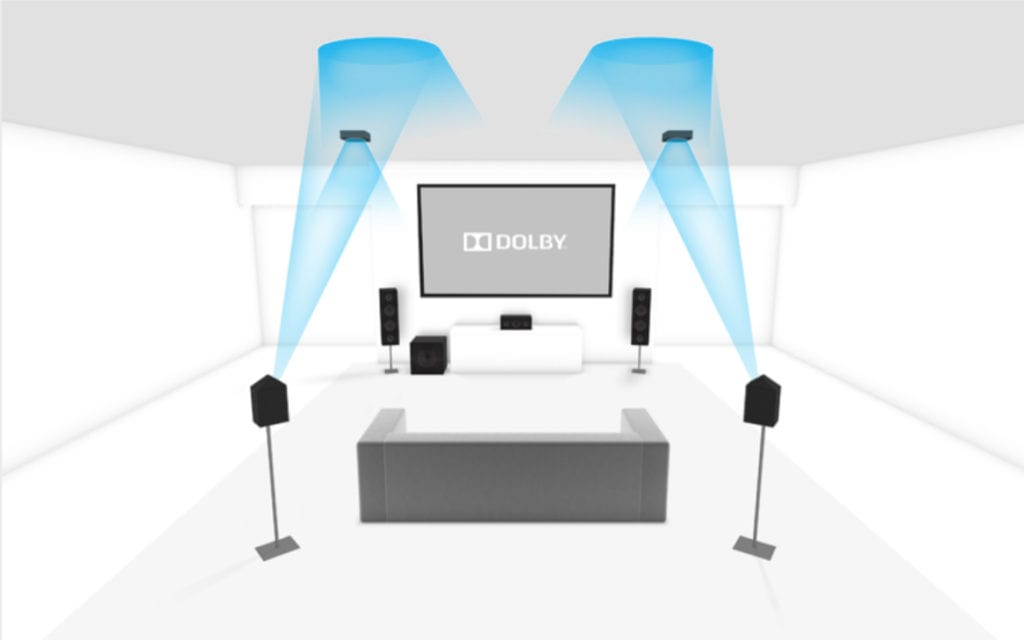
In order to experience Dolby Atmos, you will also need to play content that supports Atmos from a device that supports it as well. So, if you are streaming a movie, your streaming device will need to support Atmos. If you are watching a DVD, you will need a Blu-Ray player that supports Atmos.
If you want to know more about surround sound, check out our previous article on the best way to set up a surround sound system.
What Devices Support Dolby Atmos?
There are many devices that support Dolby Atmos nowadays, including speakers, soundbars, TVs, streaming devices, AV receivers, and even certain smartphones. Manufacturers such as Sony, TCL, Vizio, Amazon, LG, and Samsung all offer devices that are officially enabled with Atmos technology.
For a full list of devices that support Dolby Atmos, check out this site from Dolby.
What Speakers and Soundbars Support Dolby Atmos?
Speakers that support Dolby Atmos come with at least two height channels, which are either a pair of upward-firing speakers or ceiling speakers. Soundbars that support Dolby Atmos usually have internal upward-facing speakers that bounce sound off the ceiling.

You will be able to tell if a device supports Atmos by looking at how many channels it has. With traditional surround sound systems, you will only see two numbers separated by one decimal point. For example, a 5.1 channel system means it has five surround sound speakers and one subwoofer.
With an Atmos system, you will see another decimal followed by how many upward-facing speakers it has. For example, a 5.1.4 channel system has five surround sound speakers, one subwoofer, and four height channels.
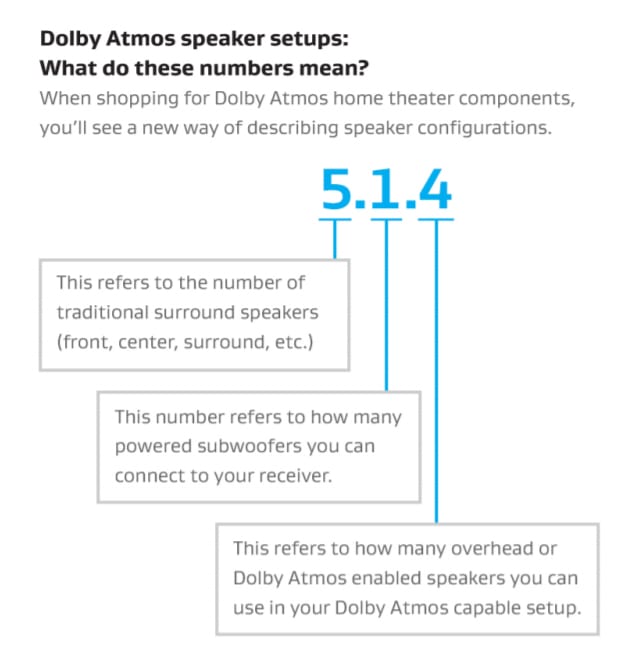
Some Atmos-compatible audio soundbars include the Samsung HW-Q90R, JBL Bar 9.1, and Nakamichi Shockwafe Pro.
If you’re planning to buy a new home theater sound system, check out our list of the best surround sound systems and the best soundbars.
What TVs Support Dolby Atmos?
TVs with an HDMI-enhanced audio return channel (eARC) port can generally support Dolby Atmos. However, that doesn’t mean TVs without HDMI eARC won’t allow you to experience Atmos at all.
You can usually tell that a TV supports Atmos by looking for the Dolby Atmos logo somewhere on the box that it came in. If you don’t have the box, you can check the user’s manual or look through the audio settings on your TV.
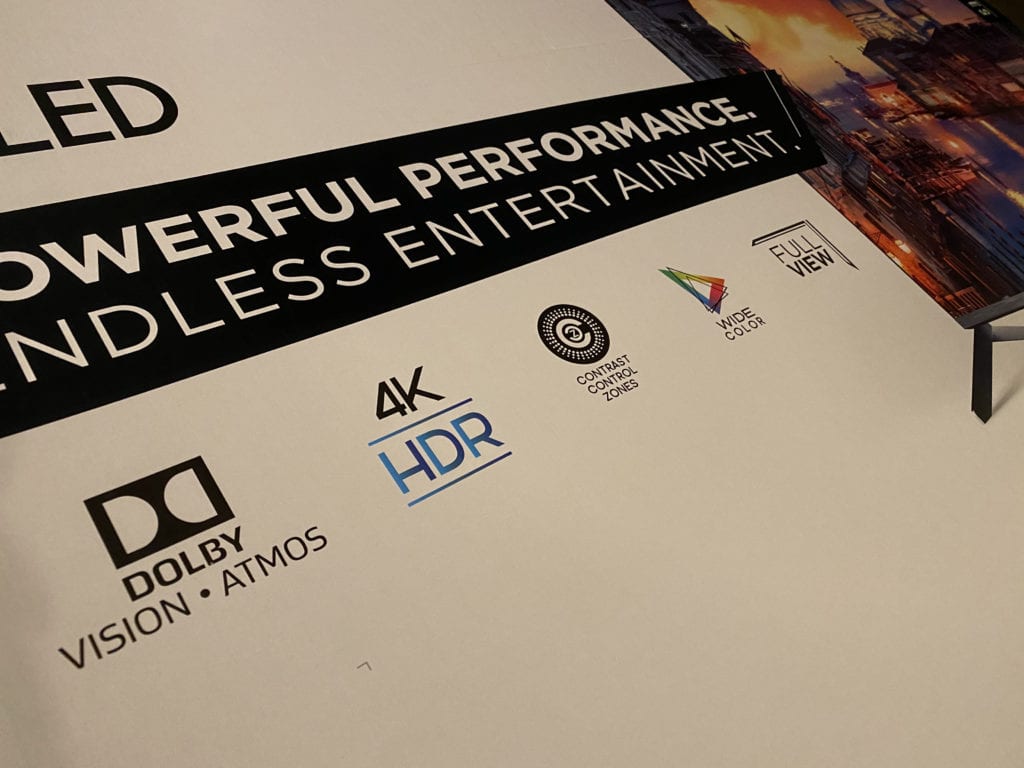
However, since Atmos is a sound format, you don’t need a TV that supports it if you have a compatible streaming device and sound system.
If you’re looking for a new TV that supports Dolby Atmos, check out our list of the best smart TVs here.
What Streaming Devices Support Dolby Atmos?
There are many streaming devices that support Dolby Atmos, including certain Amazon Fire TV devices, Roku devices, Apple TV devices, and Chromecast devices. You can also use Atmos on an Xbox and certain Blu-Ray players with Dolby TrueHD compatibility.
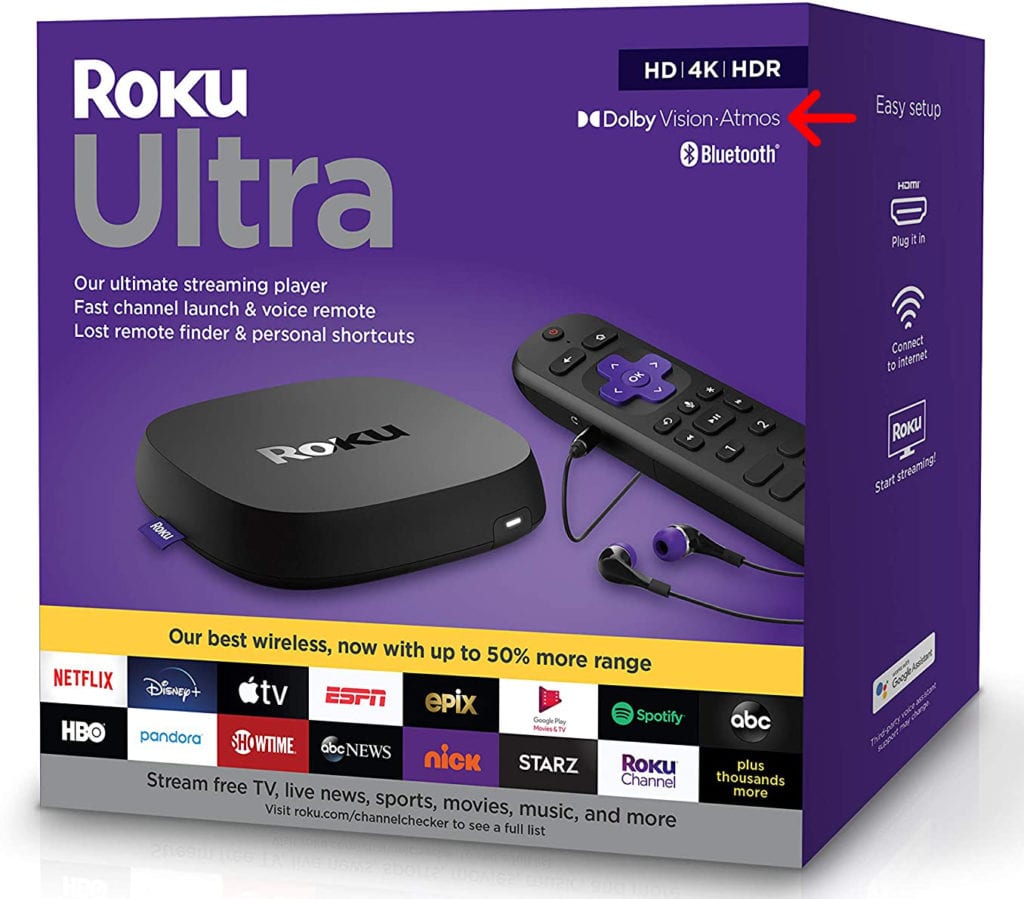
(Image Source: Amazon)
It’s worth pointing out that some streaming devices only support Atmos for one streaming service. For example, both the Amazon Fire TV Cube and Amazon Fire TV Stick 4K only support Atmos on Prime Video. Moreover, you can only access Atmos content through Chromecast Ultra on Vudu.
Compatible Roku and Nvidia Shield devices allow you to enjoy Atmos on both Vudu and Prime Video. On top of those two streaming services, Xbox devices also allow you to watch Atmos content on Netflix. Unfortunately, the PlayStation 4 is not compatible with Atmos.
The streaming device that offers the most support for Atmos is the Apple TV 4K. It’s also the only device that allows you to access Atmos content on iTunes.
If you’re looking to buy a streaming device, check out our list of the best streaming devices
here.
What Streaming Services Support Dolby Atmos?
Popular streaming services that support Dolby Atmos include Netflix, Disney Plus, Prime Video, Vudu, Apple TV, and iTunes. Your subscription plan on these services should also allow you to stream in Ultra HD.
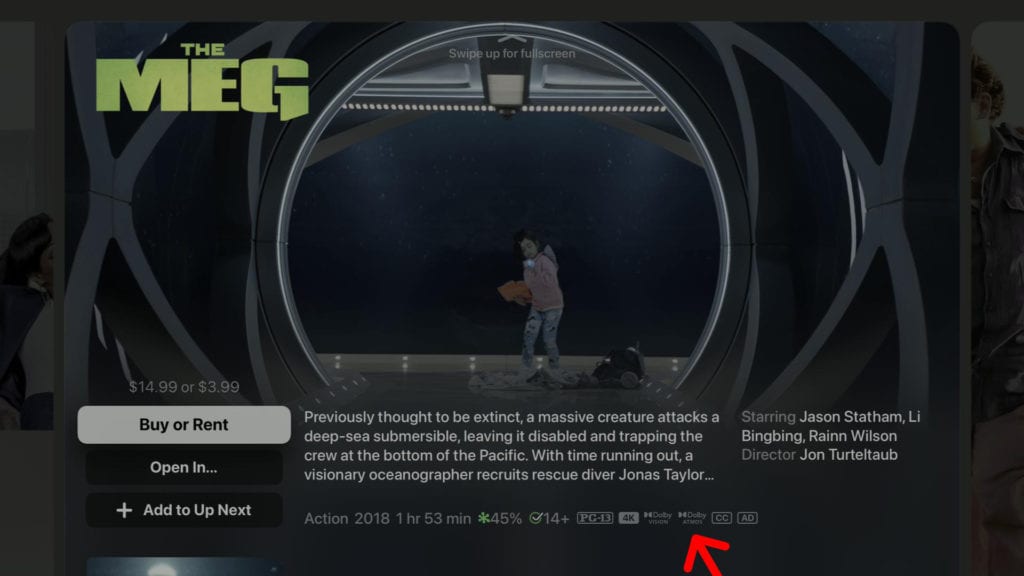
If you’re looking to replace your cable subscription, check out our list of the best streaming services here.
Is Dolby Atmos Worth It?
Dolby Atmos is worth it if you want to bring your home entertainment to life with rich and immersive sounds. With it, you can discover new elements in your favorite songs and feel like you’re inside your favorite content. If you’re a gamer, Atmos can also help you hear which direction enemies are coming from.
Atmos is still currently expanding and improving, which means it’s not going anywhere soon. If you’re looking to future-proof your home theater setup, investing in a Dolby Atmos-compatible sound system and devices will be worth it in the long run.

